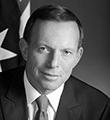Although we marked one hundred years since the Gallipoli landing yesterday, the centenary of Anzac has not passed.
Later this year, we will remember the Battle of Lone Pine and the Gallipoli evacuation, which was the only really successful part of that fraught campaign.
Over the next three years, we will remember the achievement of the Australian light horse in Sinai, at Beersheba and in the capture of Jerusalem and Damascus.
But increasingly our attention will turn here, to the Western Front, the main focus of the war, where almost 300,000 Australians fought and 46,000 died.
Gallipoli has dominated our imagination but the Western Front was where Australia’s main war was fought.
This is where our thoughts must dwell if we are truly to remember our forebears, pay homage to their sacrifice and honour their achievements.
Gallipoli was a splendid failure; the Western Front was a terrible success and we should recall our victories as much as our defeats.
In the final months of the war, the five divisions of the Australian army, fighting together for the first time, bested 39 German divisions, took 29,000 prisoners, captured 338 guns and advanced over more than 40 miles of contested ground.
It was the commander of the Australian Army Corps, General Sir John Monash, who most thoroughly brought organisation and technology to the battlefield: to break the stalemate of trench warfare and the futility of men charging against barbed wire and machine guns.
And it was on these broad slopes to the east, that Monash and his men fought what has been acclaimed as ‘the perfect battle’ at Le Hamel.
Soon, this shrine will be more than a place to mourn and reflect; it will also be a place to learn and to understand.
A new centre, bearing Monash’s name, will tell the whole story of Australia’s part in the Allied victory here on the Western Front.
When Australian troops recaptured Villers-Bretonneux on Anzac Day 1918, they helped to turn the tide of war.
Marshal Foch said of the Australians here: You saved Amiens, you saved France; our gratitude will remain ever and always to Australia.
At the 1938 dedication of this memorial, President LeBrun declared that there is no spot on the whole of the tortured soil of France which is more associated with Australian history and the triumph of Australian soldiers than Villers-Bretonneux.
Australians should congregate here, every April 25th, no less than at Anzac Cove.
Shortly, Dr Patrick Simon, Mayor of Villers-Bretonneux, will be invested as an Officer in the Order of Australia.
The Order of Australia is our country’s civilian order of merit that Dr Simon has abundantly earned, by ensuring that the memory of Australia’s glorious dead is never forgotten in the country they helped to protect.
We salute the brave French soldiers who were our allies.
As well, we acknowledge the people of Fouilloy, of Villers-Bretonneux, of Amiens and all the towns and villages of the Somme, who likewise have cherished the memory of their protectors for the past century.
Australia suffered for freedom in the Great War, but no nation paid a higher price than France.
Together, in this centenary year, we remember the tide of events that shaped our nations and that still cast their shadow over the wider world.
We do not glorify war; we honour what’s best and noblest in human nature.
We honour what our countries fought for then and still fight for today: freedom under the law, representative democracy and the universal decencies of mankind.
The centenary of the Great War should mean that Australians, once more, are as familiar with the story of the Western Front as we are with that of Gallipoli.
This is not just France’s story, it is ours too.
It should be better known, to everyone; and thanks to our work today, it will be.
[ends]

